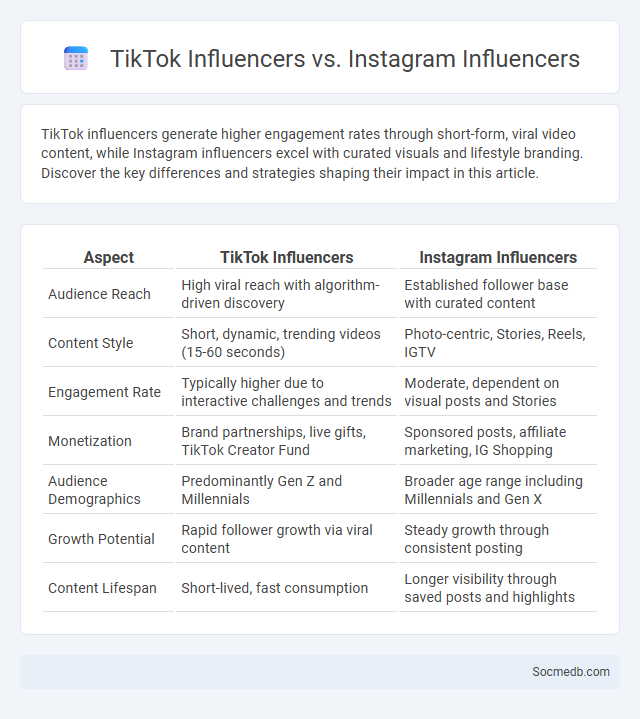
Photo illustration: TikTok Influencers vs Instagram Influencers
TikTok influencers generate higher engagement rates through short-form, viral video content, while Instagram influencers excel with curated visuals and lifestyle branding. Discover the key differences and strategies shaping their impact in this article.
Table of Comparison
| Aspect | TikTok Influencers | Instagram Influencers |
|---|---|---|
| Audience Reach | High viral reach with algorithm-driven discovery | Established follower base with curated content |
| Content Style | Short, dynamic, trending videos (15-60 seconds) | Photo-centric, Stories, Reels, IGTV |
| Engagement Rate | Typically higher due to interactive challenges and trends | Moderate, dependent on visual posts and Stories |
| Monetization | Brand partnerships, live gifts, TikTok Creator Fund | Sponsored posts, affiliate marketing, IG Shopping |
| Audience Demographics | Predominantly Gen Z and Millennials | Broader age range including Millennials and Gen X |
| Growth Potential | Rapid follower growth via viral content | Steady growth through consistent posting |
| Content Lifespan | Short-lived, fast consumption | Longer visibility through saved posts and highlights |
Understanding TikTok Influencers: Trends and Impact
TikTok influencers drive trends by leveraging short-form video content that engages millions of users globally, shaping consumer behaviors and brand marketing strategies. Their impact is evident in viral challenges, product endorsements, and cultural shifts, with engagement metrics such as follower growth and video shares serving as key indicators of influence. Brands increasingly collaborate with TikTok personalities to tap into niche audiences, capitalizing on authentic content that boosts visibility and conversion rates.
The Rise of Instagram Influencers: Visual Storytelling at Its Best
Instagram influencers have revolutionized visual storytelling by creating authentic, engaging content that resonates with diverse audiences worldwide. Your brand can leverage their creativity and large followings to boost visibility, enhance credibility, and drive consumer engagement through compelling visuals and narratives. The rise of Instagram influencers underscores the platform's power as a marketing tool where pictures speak louder than words.
Comparing Audience Demographics: TikTok vs Instagram
TikTok's audience skews younger, with approximately 60% of users aged 16-24, making it a prime platform for targeting Gen Z. Instagram attracts a more diverse age range, with strong engagement from users aged 25-34, ideal for reaching millennials and young professionals. Understanding these demographic differences helps you tailor your content strategy to maximize reach and engagement on each platform.
Content Creation Styles: Short-Form vs Curated Feeds
Short-form content excels in capturing quick attention through bite-sized videos and concise posts, ideal for platforms like TikTok and Instagram Reels. Curated feeds emphasize quality over quantity by aggregating and sharing relevant content, enhancing your brand's authority and engagement on sites such as LinkedIn and Pinterest. Choosing the right content creation style depends on your audience's preferences and your social media goals.
Engagement Rates: Which Platform Drives More Interaction?
Instagram consistently leads in engagement rates, with an average of 1.22% per post, outperforming Facebook's 0.08% and Twitter's 0.045%. TikTok also shows significant interaction, boasting engagement rates around 5.3%, driven by its short-form video content. Brands targeting high user engagement should prioritize Instagram and TikTok for their interactive features and active audience base.
Building Authentic Connections: The Power of Online Communities
Building authentic connections within online communities fosters trust and meaningful engagement, enhancing brand loyalty and user retention. Platforms like Facebook Groups and Reddit enable users to share experiences and support, creating a sense of belonging that drives active participation. Leveraging genuine interactions and personalized content strengthens relationships, turning digital connections into long-term advocates.
Monetization Strategies: Influencers vs Community Builders
Monetization strategies for social media differ significantly between influencers and community builders. Influencers primarily generate income through sponsored content, brand partnerships, and affiliate marketing, leveraging personal reach and engagement metrics. Community builders focus on membership fees, exclusive content, and merchandise sales, creating sustainable revenue by fostering loyal, interactive audiences that value your unique community experience.
Platform Algorithms: How They Shape Influencer Growth
Platform algorithms prioritize user engagement by analyzing interactions such as likes, comments, and shares to determine content visibility, significantly impacting influencer growth. These algorithms favor content that generates higher engagement rates, enabling influencers who create relatable and timely posts to expand their reach organically. Understanding and adapting to algorithm changes allows influencers to optimize their strategies for maximum audience growth and brand partnerships.
Brand Collaboration Opportunities: TikTok, Instagram, and Community Spaces
TikTok and Instagram offer dynamic brand collaboration opportunities through influencer partnerships, targeted ads, and interactive content formats that boost visibility and engagement. Community spaces within these platforms enable authentic audience interactions, fostering brand loyalty and driving organic growth. Leveraging these tools effectively can enhance your marketing strategy and expand your reach across diverse user segments.
Future Trends: Influencers, Community Building, and Evolving Social Media
Future social media trends highlight the growing influence of micro and nano influencers who drive authentic engagement within niche communities. Enhanced community-building tools foster stronger connections, enabling brands and users to create personalized experiences through interactive content and tailored social interactions. Platforms are evolving with AI-driven algorithms and immersive technologies like augmented reality, shaping a more dynamic and user-centric social media landscape.
 socmedb.com
socmedb.com